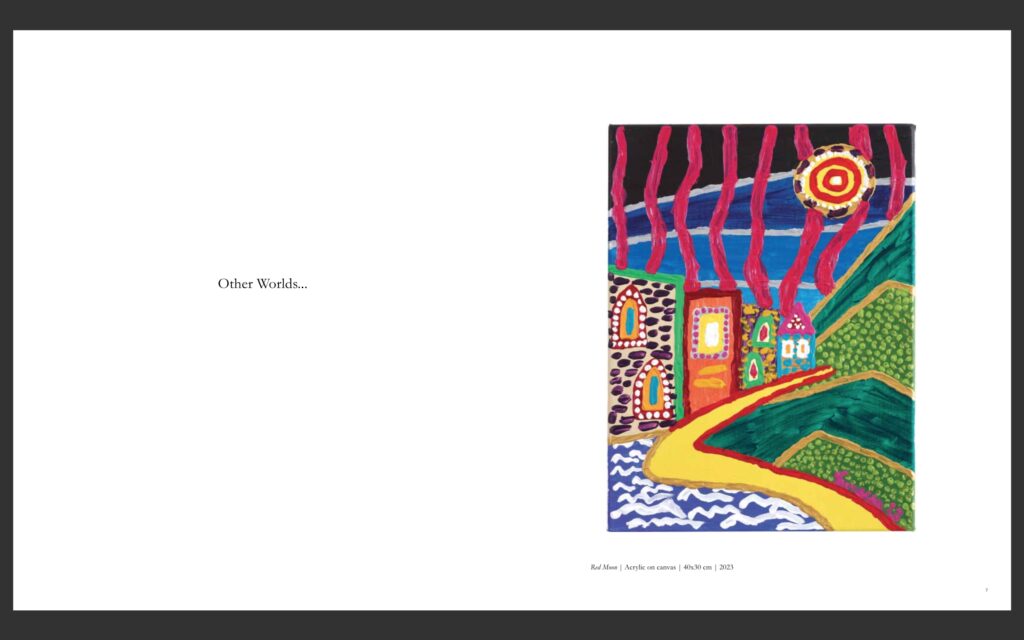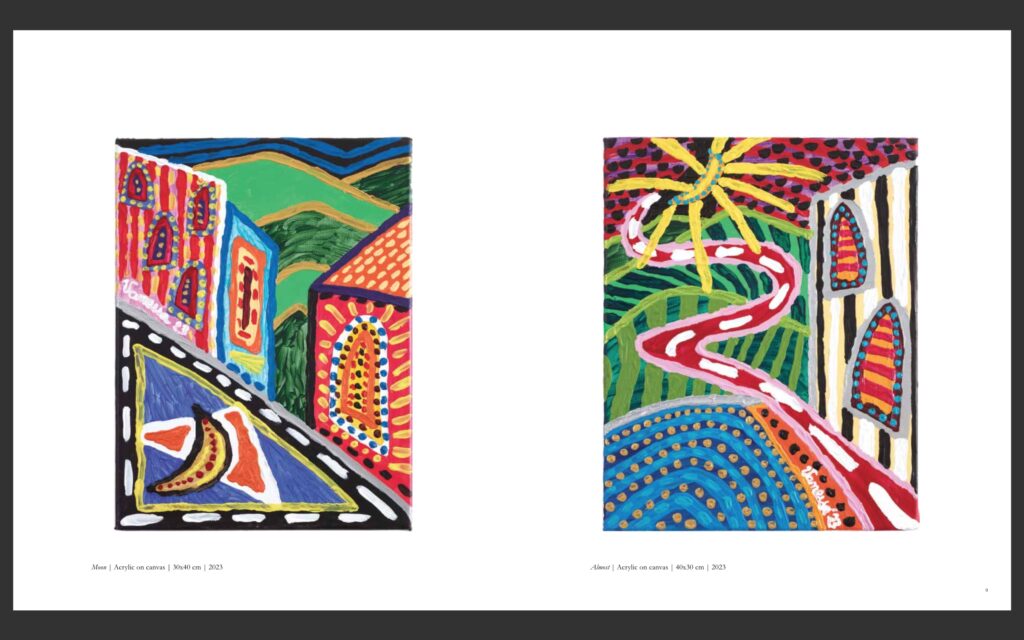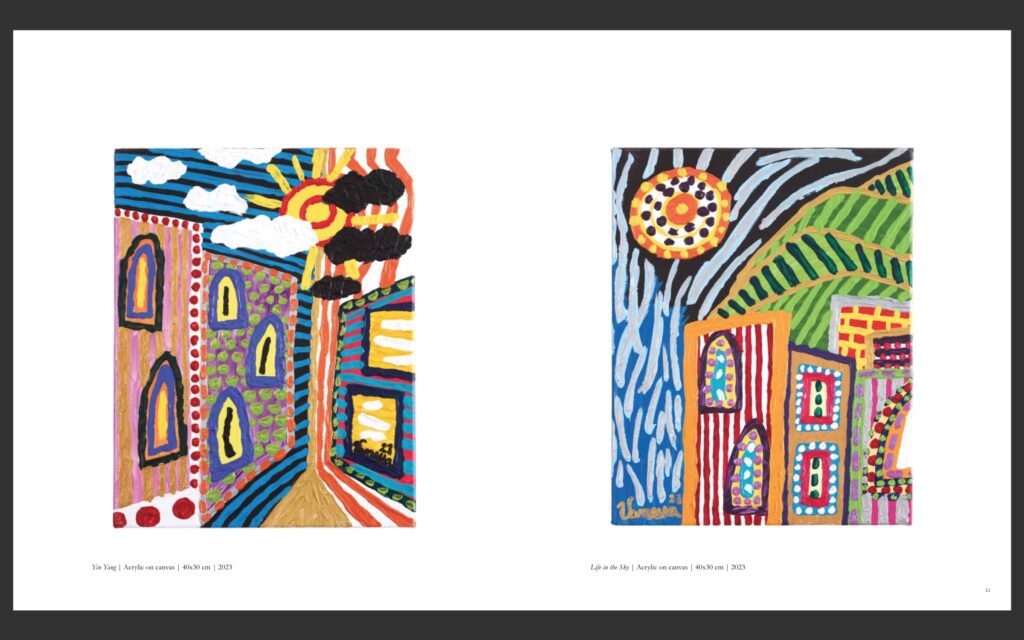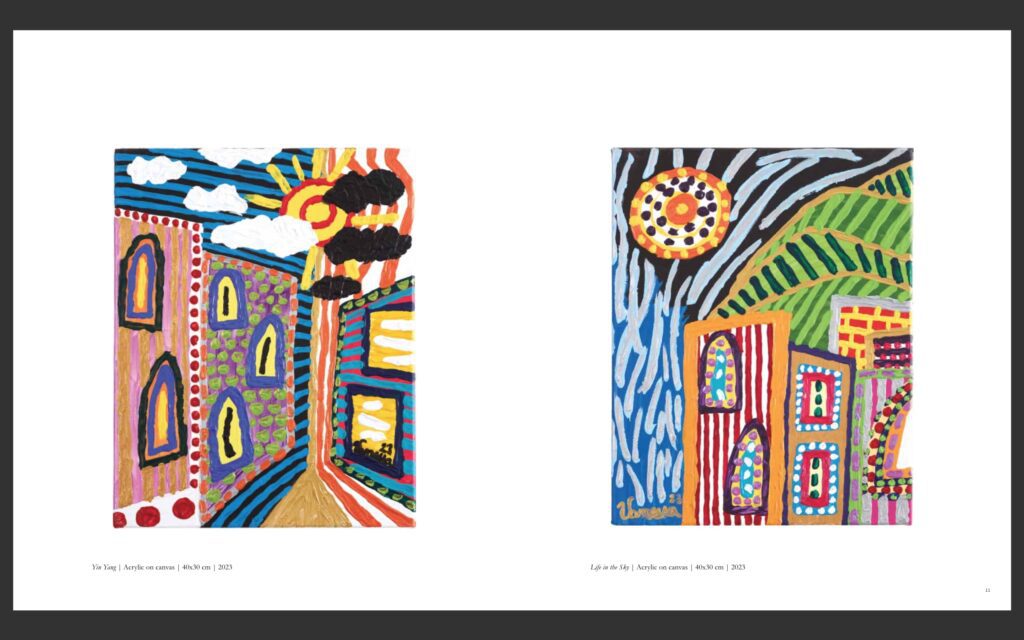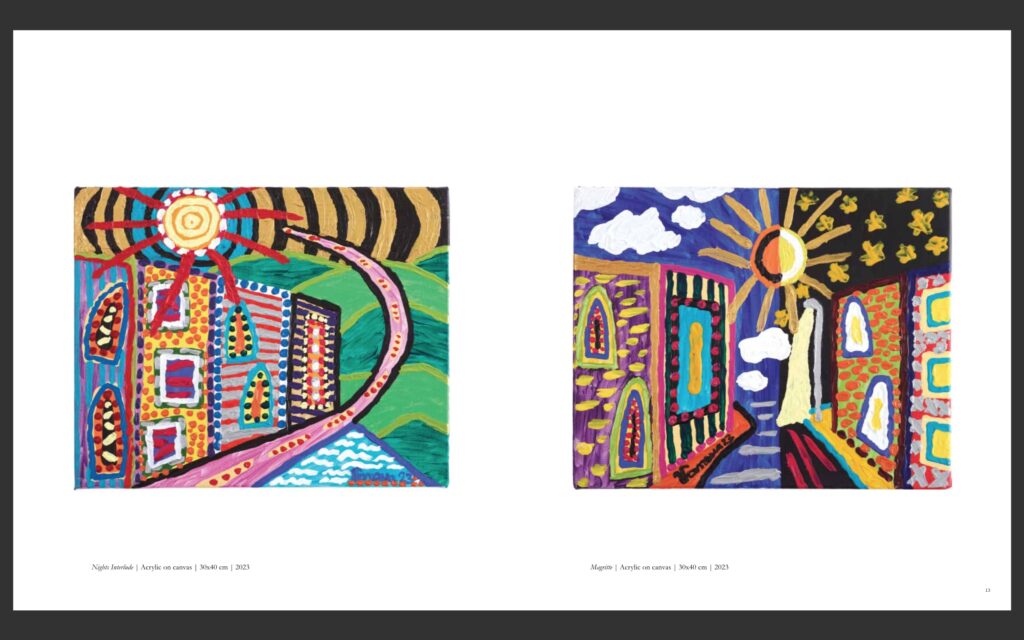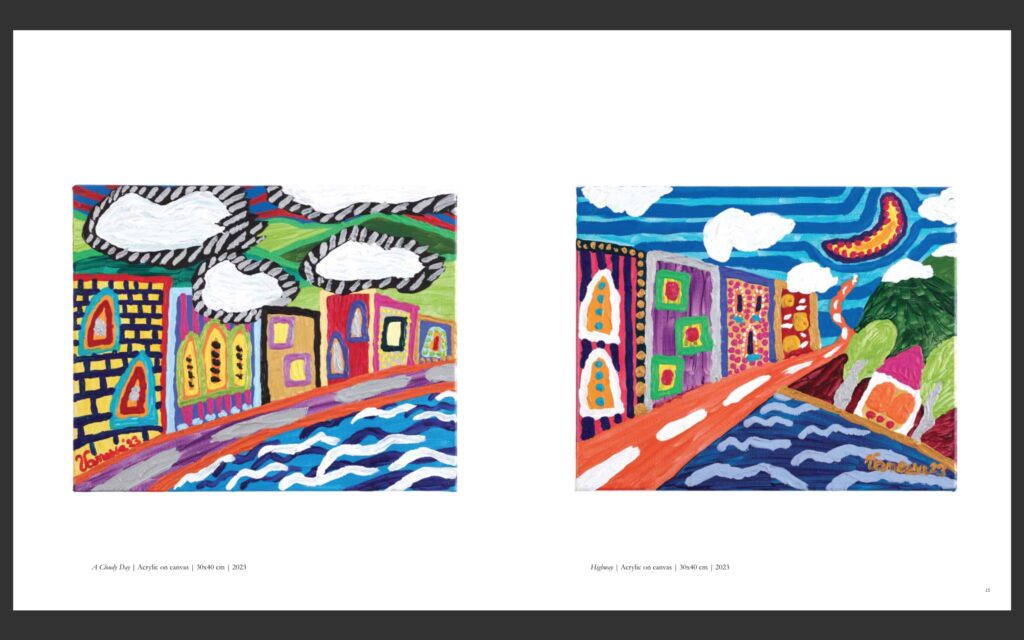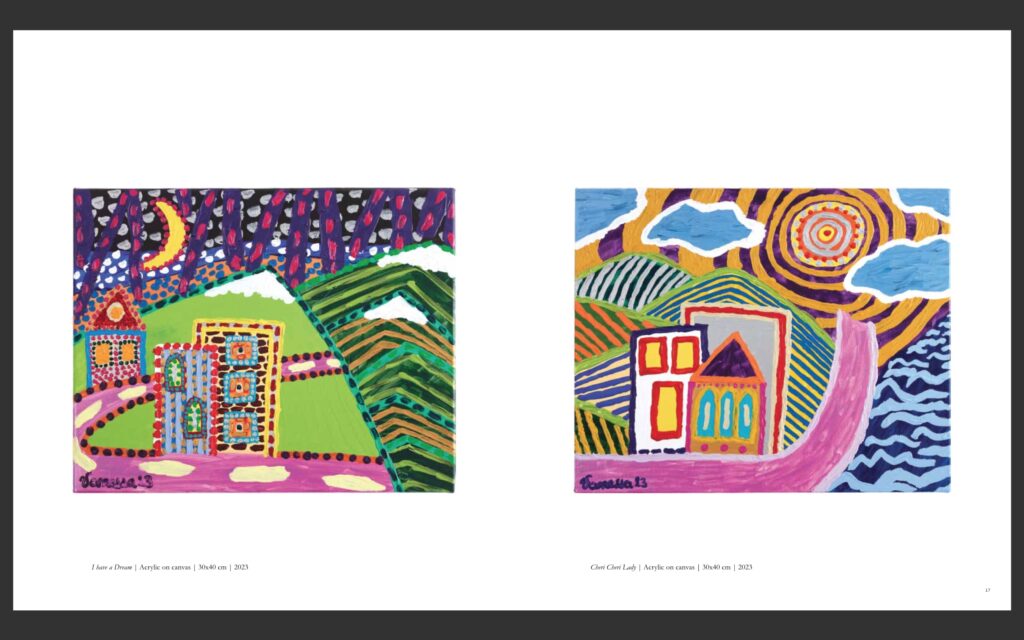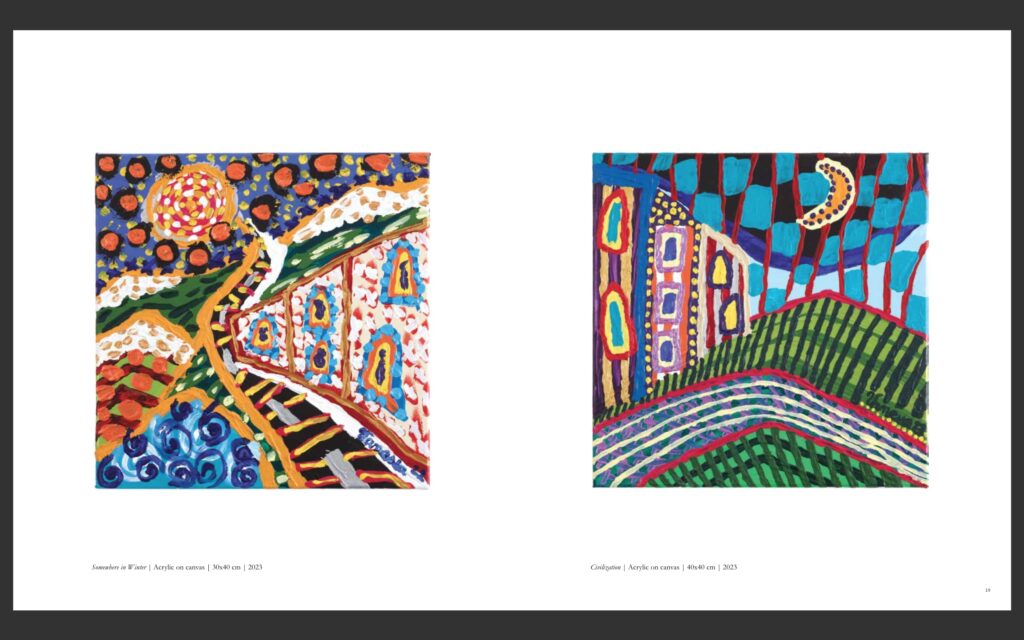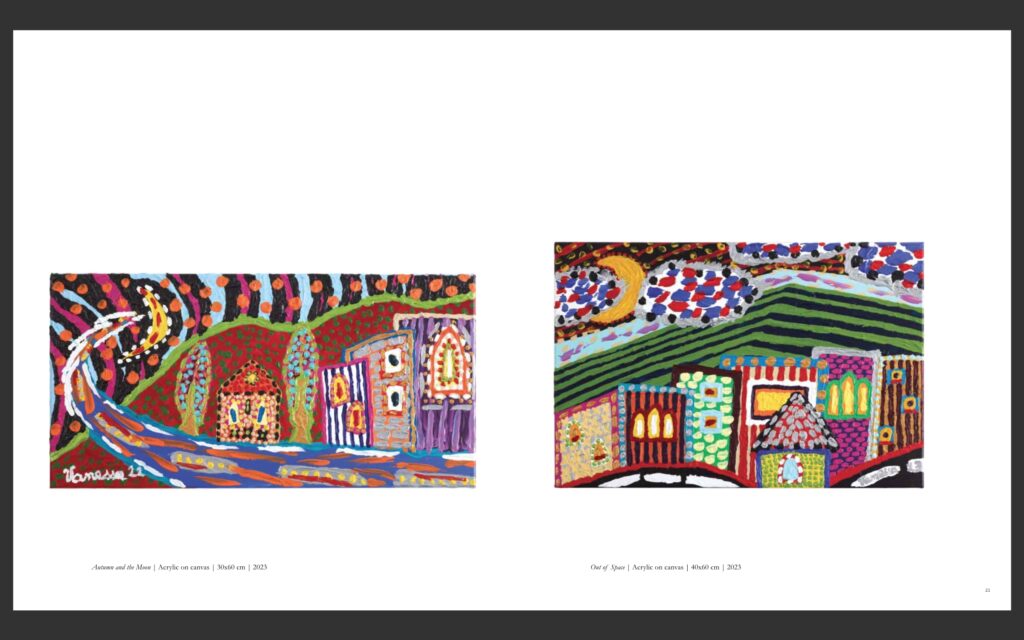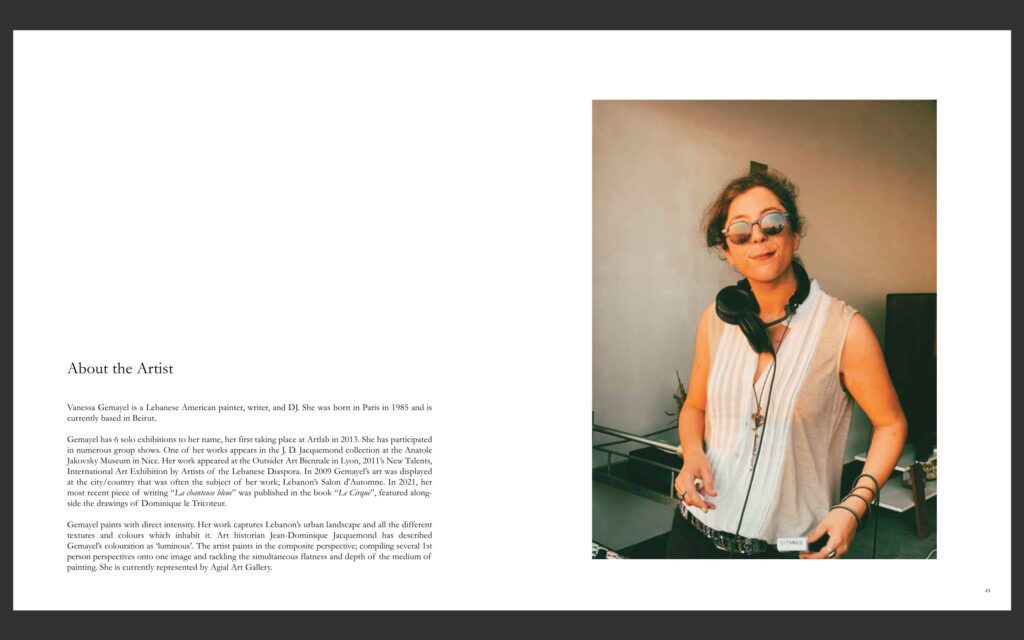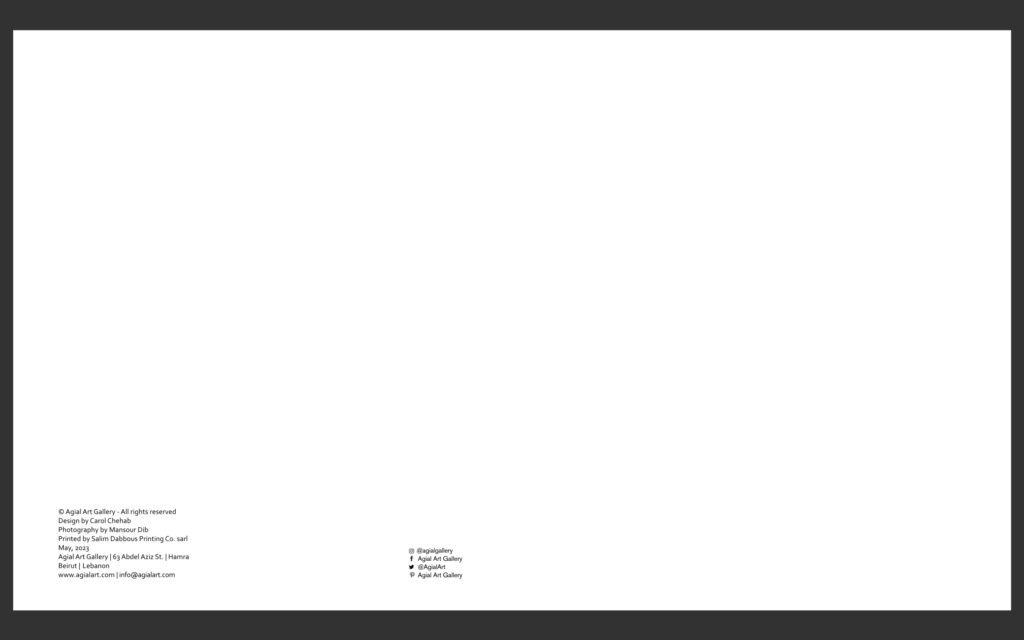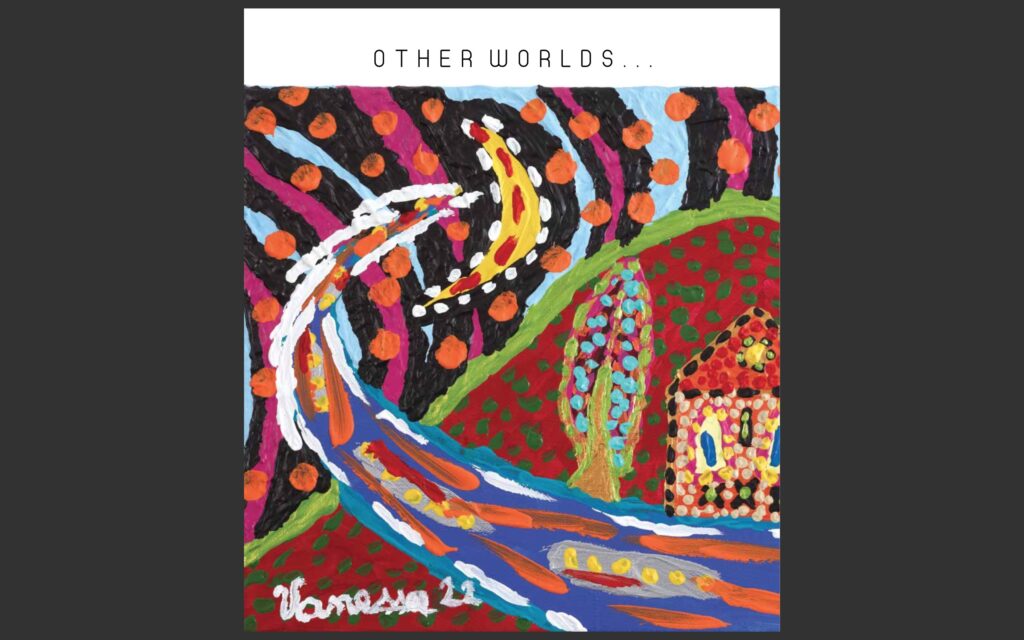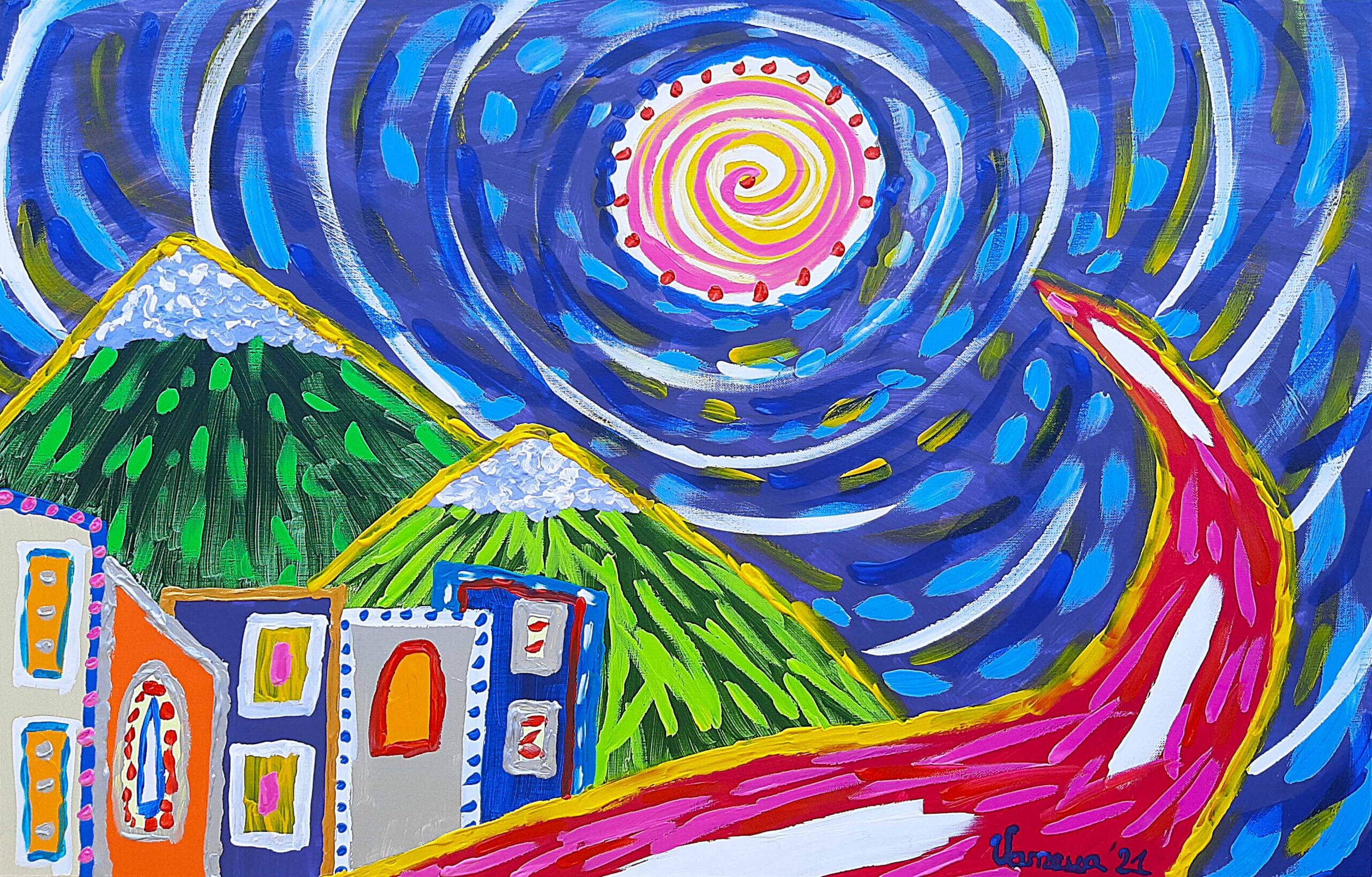June 8th to July 8th 2023 at Agial Art Gallery, Beirut.
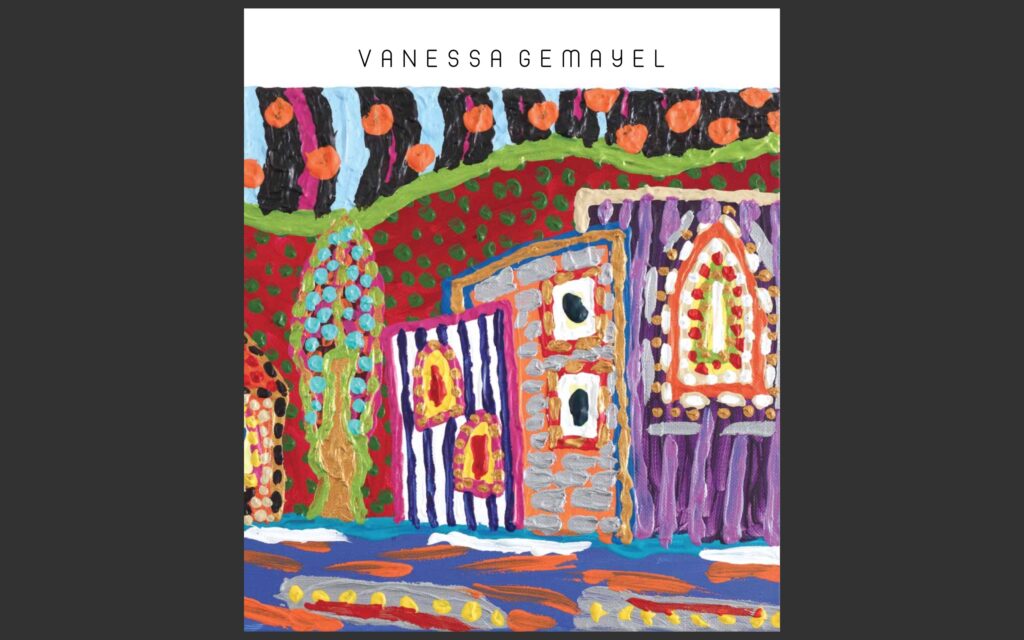
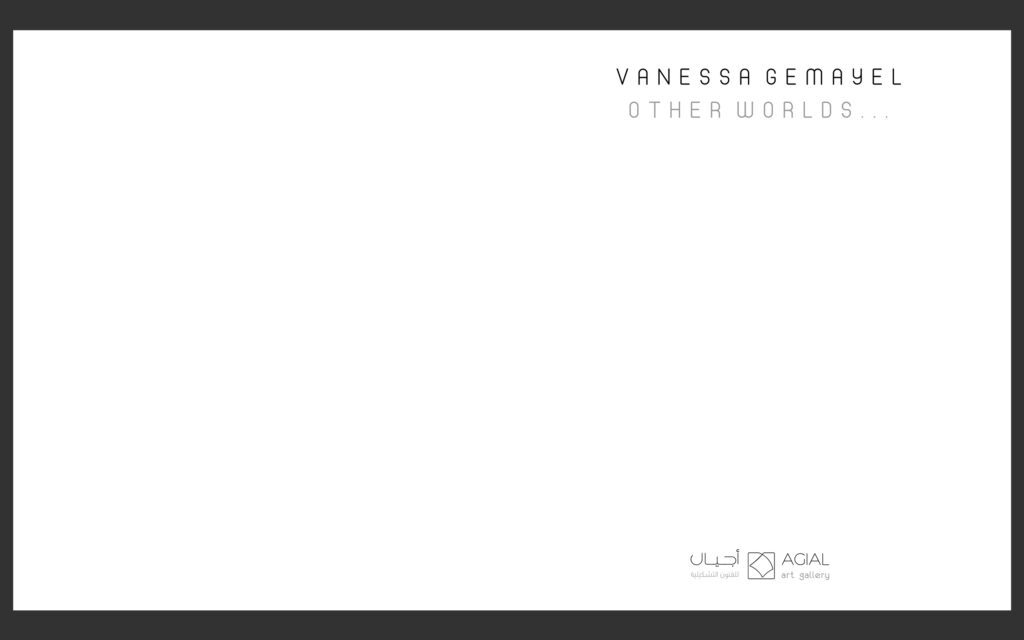
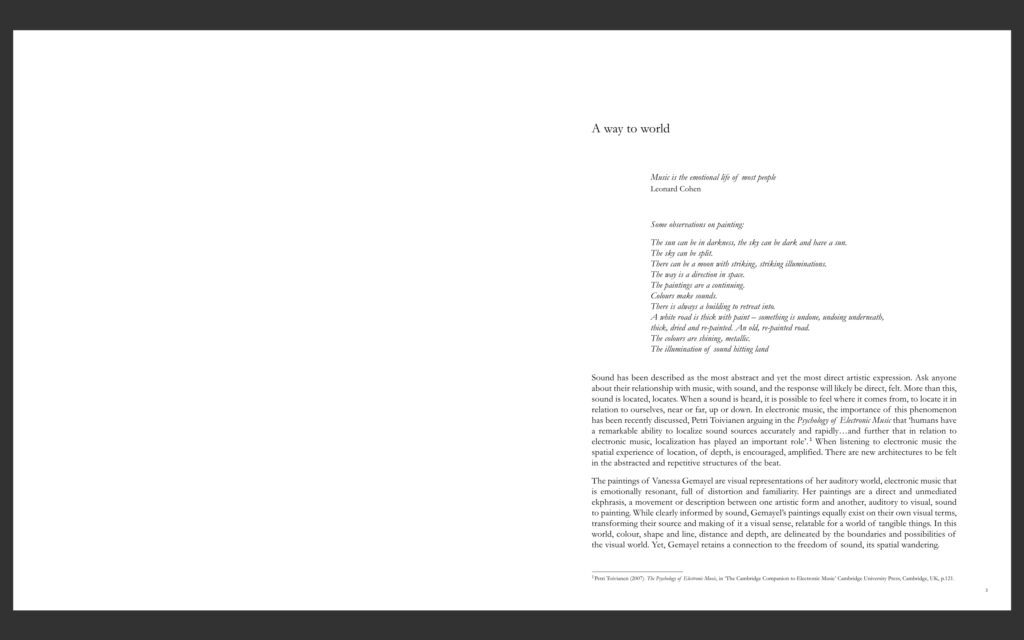
Vanessa Gemayel
A way to world
Music is the emotional life of most people
Leonard Cohen
Some observations on painting:
The sun can be in darkness, the sky can be dark and have a sun.
The sky can be split.
There can be a moon with striking, striking illuminations.
The way is a direction in space.
The paintings are a continuing.
Colours make sounds.
There is always a building to retreat into.
A white road is thick with paint – something is undone, undoing underneath,
thick, dried and re-painted. An old, re-painted road.
The colours are shining, metallic.
The illumination of sound hitting land.
Sound has been described as the most abstract and yet the most direct artistic expression. Ask anyone about their relationship with music, with sound, and the response will likely be direct, felt. More than this, sound is located, locates. When a sound is heard, it is possible to feel where it comes from, to locate it in relation to ourselves, near or far, up or down. In electronic music, the importance of this phenomenon has been recently discussed, Petri Toivianen arguing in the Psychology of Electronic Music that ‘humans have a remarkable ability to localize sound sources accurately and rapidly…and further that in relation to electronic music, localization has played an important role’.[1]When listening to electronic music the spatial experience of location, of depth, is encouraged, amplified. There are new architectures to be felt in the abstracted and repetitive structures of the beat.
The paintings of Vanessa Gemayel are visual representations of her auditory world, electronic music that is emotionally resonant, full of distortion and familiarity. Her paintings are a direct and unmediated ekphrasis, a movement or description between one artistic form and another, auditory to visual, sound to painting. While clearly informed by sound, Gemayel’s paintings equally exist on their own visual terms, transforming their source and making of it a visual sense, relatable for a world of tangible things. In this world, colour, shape and line, distance and depth, are delineated by the boundaries and possibilities of the visual world. Yet, Gemayel retains a connection to the freedom of sound, its spatial wandering.
A first encounter with Gemayel’s paintings joins visual and auditory senses. Her colours make noise, screech, express an overwhelming, shining brightness, contrast, that is heard, felt, in the body as well as viewed, seen on the canvas. In this moment of ekphrastic disturbance the line between viewer and painting dissolves, there is no intermediary, interpreter. Enter directly from here and the painting begins to understand you.
See it that way.
Gemayel’s paintings are a journey, a way to world.
Spatial organization is the strongest marker of Gemayel’s paintings. She is holding to the order of space, perspective. We are in place, the sun is in a sky, the ground is moving away from us. Buildings rise. The order of perspective she employs might shift but never entirely disappears.
As I look I am enjoying a feeling, an unfolding experience. There is a transformation. This is closer to experiencing music than painting, the paintings are unfolding in real time. They are time.
Paintings are not often experienced in time.
Try it like that.
In each painting there is a road, a road stretching away from the foreground, reaching to sky, moon, sun. The road picks the viewer up from the foreground and takes them in, up, away. This is the most direct description of a journey, the road laid out. Of course this is an entry into a new world, the road to the moon, around the sun.
The work of Gemayel holds aloneness and togetherness in relation, has the ability to be at once alone and together in succession, still separate but relatable. Each painting might be seen on its own, perhaps in a darkened room, through a small pinhole, a shrouded box opening a tiny eye to a glimpse of cloud, silver, a screech of yellow, lamplight, sun, moon, sea. At the same time, the paintings could be arranged in a line, a singing succession of this world. Seen together in this way they become the small differences, gaps between one experience and another, and in this way this pile, this road, of paintings, might be seen as the leaves of books, an accretion of moments becoming lives.
Solitude is often seen as a problem, dangerous, perhaps sad. And yet, in the paintings of Gemayel there is a deep joy in streets emptied of human and animal life. What else can be felt with the bright lights of the moon, the sun, the red outline of a road stretching back, the silver tracing clouds.
There is joy and life in solitude, and solitude in relation to others. If you enter the world of Gemayel, you will walk the streets alone and in company. Enter with her and you will feel the certainty of solitude alongside the continuities of the world. And, if you allow it, you will look directly and see the shining, shining illumination of sound hitting land.
Amy Todman
[1] Petri Toivianen (2007). The Psychology of Electronic Music, in ‘The Cambridge Companion to Electronic Music’ Cambridge University Press, Cambridge, UK, p.121.
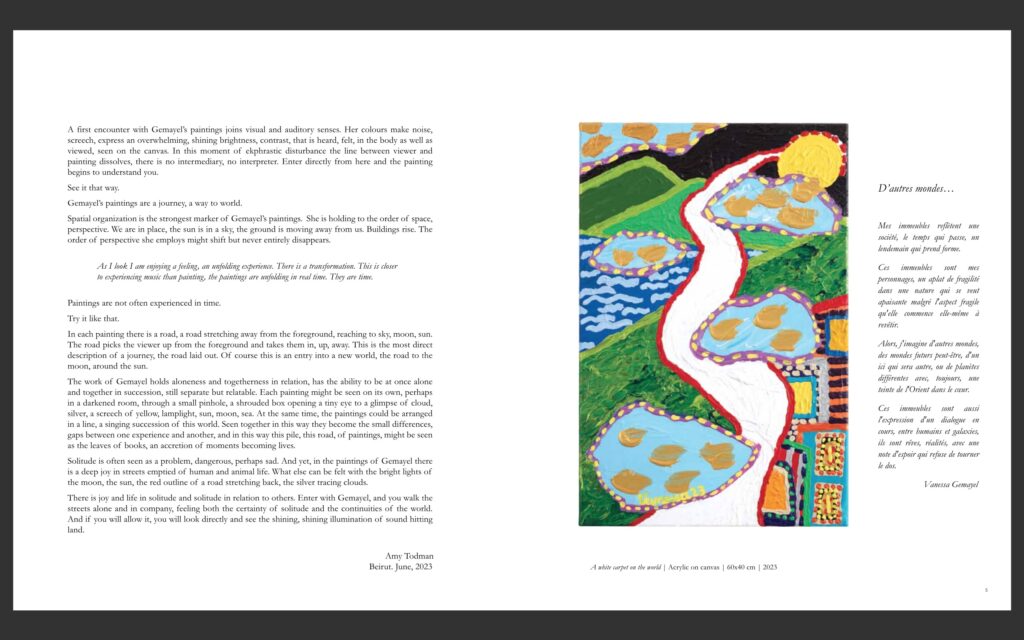
D’autres mondes…
Mes immeubles reflètent une société, le temps qui passe, un lendemain qui prend forme.
Ces immeubles sont mes personnages, un aplat de fragilité dans une nature qui se veut apaisante malgré l’aspect fragile qu’elle commence elle-même à revêtir.
Alors, j’imagine d’autres mondes, des mondes futurs peut-être, d’un ici qui sera autre, ou de planètes différentes avec, toujours, une teinte de l’Orient dans le cœur.
Ces immeubles sont aussi l’expression d’un dialogue en cours, entre humains et galaxies, ils sont rêves, réalités, avec une note d’espoir qui refuse de tourner le dos.
Vanessa
Beyrouth, Liban
20-05-2023
